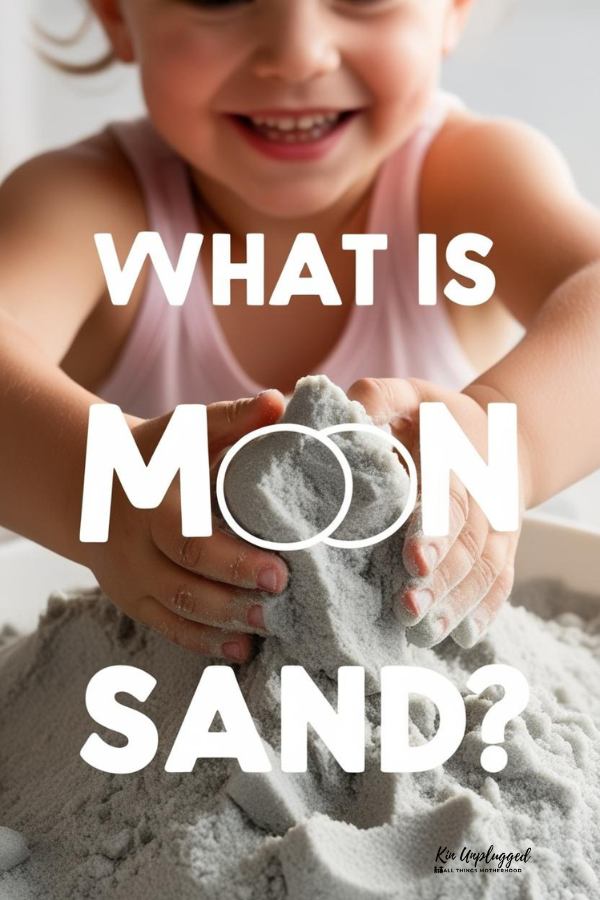Are you wondering how to make moon sand? I’m going to guess that you’re looking for a safe, easy and fun way to have fun with your kids!
In this article, I’ll share with you the easiest moon sand recipe ever that I use at home with my own children. I’ll share how to make it baby-safe too for our little ones who seem to want to taste everything!
First though, you may be here and wondering what exactly moon sand is.
What is moon sand?

Moon sand is a fun, moldable sensory play material that feels soft and crumbly but holds its shape when pressed together. Kind of like damp beach sand but without the mess. It’s super easy to make at home with just a few simple ingredients (I’ll get to that in a bit).
GET: The Ultimate Toddler Behaviour Toolkit
If you’re wondering “moon sand vs kinetic sand”, the biggest difference is that moon sand is made with flour and oil, giving it a soft, moldable texture, while kinetic sand has a stretchy, almost magical movement thanks to a special polymer. Both are great for sensory play but moon sand is a budget-friendly DIY option that’s perfect for little hands.

And if you’re looking for how to make moon sand, don’t worry. It’s beyond simple. Just a couple of pantry staples and you’ll have hours of creative, hands-on fun.
Want the recipe? Let’s get into it!
The Easiest DIY moon sand recipe

If you’ve been wondering how to make moon sand, you’ll be happy to know it takes just two basic ingredients you probably already have in your kitchen.
Simple ingredients you need
- 8 cups of flour (regular all-purpose works great!)
- 1 cup of oil (baby oil for a silky texture or coconut/vegetable oil if you want a taste-safe version)
Step-by-step mixing instructions
- Pour the flour into a large bowl or sensory bin. This will be the base of your moon sand.
- Slowly add the oil, mixing as you go. Use your hands (or a spoon) to blend everything together until it reaches a crumbly, moldable consistency like wet sand.
- Test it out. If it feels too dry, add a little more oil. Too wet? Sprinkle in a bit more flour.
- Time to play. Kids can shape it, mold it and squish it to their heart’s content.
If you’re looking for how to make moon sand for babies, just swap baby oil for coconut or vegetable oil to make it safe in case little ones decide to taste-test. It’s perfect for sensory play without any worry.

Tips for the best moon sand texture
Getting the perfect moon sand texture is all about balance. If you’ve tried how to make moon sand and it’s not quite right, I’ve got some easy fixes to get that soft, moldable and crumbly consistency just right.
How to adjust consistency
Too dry? If your moon sand won’t hold its shape when squeezed, just add a little more oil (a tablespoon at a time) and mix well.
Too wet? If it feels sticky or too greasy, sprinkle in more flour and knead it in until you reach the perfect sandy texture.
Best storage methods to keep it soft and reusable
- Store your moon sand in an airtight container or ziplock bag to prevent it from drying out.
- If it does feel dry after sitting for a while, just mix in a few drops of oil to bring it back to life.
- Keep it in a cool, dry place. No need for the fridge.
If you’re also curious about how to make sand for other sensory play ideas, you can try mixing salt with a bit of food coloring or blending dry oats into a fine, sand-like texture. For that classic, moldable fun though, moon sand is definitely the way to go!
3 fun ways to play with moon sand
Moon sand is such a fun, hands-on sensory activity and there are so many creative ways to play with it.

Sensory bins, molds and themed play ideas
- Sensory bin fun. Fill a shallow bin with moon sand, add scoops, cups and small toys and let the messy fun begin!
- Use molds and cookie cutters. Moon sand holds its shape really well, so use silicone molds, measuring cups or cookie cutters to make fun designs.
- Themed play. Create a mini beach scene with toy sea animals, a construction site with little diggers or even a bakery setup with play cupcakes.
READ: How to Encourage & Reap the Benefits of the Independent Play
Safe cleanup tips for mess-free fun
- Play on a tray or in a large bin to contain the mess.
- Use a vacuum or dry brush to sweep up any stray bits. Unlike kinetic sand, moon sand can be a little crumblier but it’s still easy to clean.
- Store it properly in an airtight container so it stays soft and ready for next time.
I hope this has been helpful and clear enough for you to get to making some fun moon sand with your kids!






1 Comment
I didn’t know playing in the sand box could get any better!